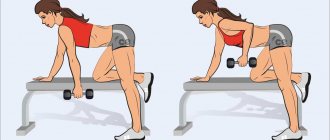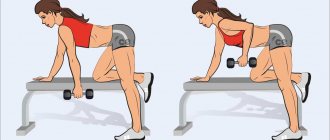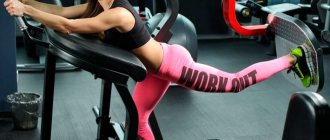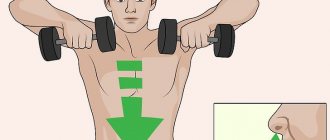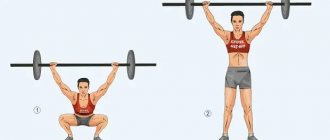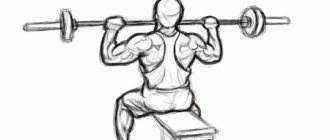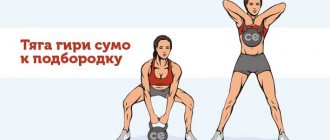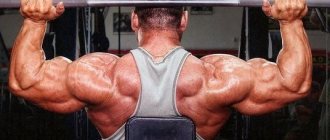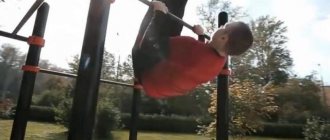The deadlift (ST) is one of the important basic exercises that is necessary for working the back muscles, as well as building muscle mass in general. Some athletes are confident that there is no complete replacement for ST, however, beginners or athletes after injuries should temporarily abandon the exercise, replacing it with more gentle activities. You should definitely replace the deadlift with lower back pain, after spinal muscle injuries, with intervertebral hernias or muscle sprains. Alternative ST complexes can be performed by people with non-standard body proportions: very tall, long torso. If the exercise technique is not easy for beginners, it may be due to weak back muscles. Perform alternative complexes, and only after that include deadlifts in the program.
How to replace deadlifts
There is no definite answer to this question; other basic exercises will not be a complete replacement. It is necessary to combine isolated exercises to provide load on all muscle groups that work in the CT. An alternative to the deadlift is chosen depending on what goal the athlete is pursuing. It is necessary to take into account the preparation, the weight with which the bodybuilder works, and the reason for the replacement.
- If an exercise is contraindicated due to injury, it should be abandoned for the entire recovery period. If the knee joints are damaged, instead of the ST, bend over with a barbell from a standing position and hyperextension. Such exercises provide the back muscles with the required load.
- For injuries to the knees and hip joints, instead of the CT, you can perform a similar exercise, but with straight legs.
- If the restrictions relate to axial load, isolated exercises are necessary: T-bar rows, leg press, bending and extension of legs while lying down, sitting, rowing a horizontal block, raising or abducting legs in the simulator.
- It is easier for beginning athletes to master the deadlift technique with a body bar or an empty bar. To practice technical aspects, perform ST with dumbbells in a Smith machine. This machine controls the movements and trajectory of the bar. Additionally, you can increase the load on the back muscles by performing chest-centric rows and isolation exercises - the same as when recovering from injuries.
- If an athlete has non-standard body proportions, instead of ST they perform the following types of deadlifts: straight legged, Romanian. They are made in combination or individually.
Choosing grip width
The traditional grip implies a right angle in the elbow joint when the barbell is pulled to the belt, but the grip can be changed to emphasize different muscles.
- The narrower the hands are on the bar , the more emphasis is placed on the work of the diamond-shaped ones;
- and with a wide grip, the teres major muscles, the back of the deltoid muscles, and also the trapezius muscles are involved in the work.
Replacing exercises for back and lower back pain
One of the advantages of ST is that the exercise involves work and provides load to a large number of muscles. In just a quarter, you can significantly improve the appearance and endurance of your back muscle masses.
If an athlete experiences pain in the back or has had a lower back injury, it is necessary to replace ST with other, more gentle exercises. It is forbidden to perform deadlifts for those athletes whose nature of injuries excludes axial loads on the back - instead they do extensions: in the simulator, reverse and classic. It is these three options that allow you to load the long back muscles. This will not increase muscle mass and relief, but will strengthen the back corset and relieve the load on the spine. Move the classic version of the extension to the end of the lesson, and perform the reverse version at the beginning, immediately after the warm-up.
Precautions
No matter what training and athletic form an athlete has, a certain number of precautions must be followed:
- Always use a safety harness when lifting more than your own weight. If the goal is to pump up the muscles of the lumbar region, it is better to use hyperextension with additional weights.
- Never perform an exercise in a snatch style, despite the fact that it seems easier to lift the barbell in the lower phase.
- Even if you are in the waist, still arch your lower back and maintain the correct angle.
Recipes for healthy eating
Soup with carrots, potatoes and vegetables
- 0.5 g Protein
- 0.2 g Fat
- 2.9 g Carbohydrates
- 14 kcal
40-60 minutes
- #vegetarian dish
- #dietary
- #for vegans
- #carrot
- #low calorie
- #dinner
- #vegetables
- #vegetable dish
- #olive oil
- #onion
- #celery
- #spices
- #dinner
- #garlic
Other recipes
Exercise mechanics
Deadlift involves the work of large groups of joints, except for the elbow and knuckle. It strengthens the joints, muscles of the back and legs, and increases the strength parameters of the legs. Benefits of the exercise:
- different muscle groups are involved in the work at the same time;
- strength indicators and muscle mass increase;
- ligaments are strengthened.
How to perform ST.
- Place your feet under the bar so that it is above the midline of the foot. Turn your socks slightly outward.
- Bend toward the bar by bending your hips. Try not to bend your knees.
- Take the bar with an overhand grip, placing your palms at shoulder level.
- Gradually bend your knees until your shins begin to touch the bar. The projectile should not move.
- Push your chest forward without lifting the barbell. This way the spine will take the correct and safe position.
- Lift the barbell using your legs. The pelvis and chest should rise simultaneously, synchronously.
The Importance of Stretching
Unfortunately, this is not a bench press where poor stretching will not ruin the technique. We'll need a good stretch. The fact is that the starting position for the exercise requires good flexibility of the lower back and back. This pull is associated with lumbar flexion. Therefore, you will need to stretch it as much as possible.
Poor stretching will prevent you from getting into the desired position, which will prevent you from doing the exercise correctly. Correct execution means smoothness, flexibility and control over every movement. Remember this.
A set of exercises to replace deadlifts
An alternative to ST is selected depending on what goal the athlete is pursuing, as well as on the nature of the activity: in the gym you can perform exercises on machines or work with an upper block. At home, you can get by with working with dumbbells or, if you have one, a barbell.
Working on trapezoids
For maximum quality work on the trapezius muscles, you can replace the deadlift with three exercises. The main thing is to row the barbell with a straight grip in an inclined position. Additional exercises are shrugs, dumbbell rows to the stomach. Additional ones will increase the load on the trapezius, help increase the relief, but will not put stress on the knees, and will reduce the risk of lower back injuries.
Bent-over barbell row
- Feet are shoulder-width apart, legs slightly bent. While bent over, grab the projectile with a straight or overhand grip.
- Carefully straighten up while lifting the projectile. Don't bend your arms, watch your elbows.
- Bend a little, lean forward. Watch for tension in your lower back. Do not lift the bar above your knees.
- Pull the bar toward your upper abdomen, pushing your elbows back. Raise your elbows as high as possible.
- Try not to use your biceps, tense your back muscles. Move smoothly - jerking leads to injury.
Shrugs
This exercise is performed with dumbbells - an easier option for beginners, or a barbell - when the athlete has mastered the technique. It can be done standing, lying on a horizontal or inclined bench.
- Hold the projectile down, arms straight.
- Raise your shoulders higher. The back and elbows are straight, no bends. Tighten your back muscles and abs.
- Fix at the top point, pause there for one or two seconds. Drop your shoulders.
Work with light weight so that you can perform at least ten repetitions.
Dumbbell rows to the stomach
This exercise can be performed in the gym or during home workouts. Trainers advise starting a complex with it to work the back muscles, trapezius and even the latissimus. Do it slowly, without sudden movements or jerks, so as not to injure muscles or ligaments.
- Take the apparatus, bend your knees and bend over.
- Lower the exercise equipment and begin deadlifting. The main emphasis is on the shoulder blades, the direction of the dumbbells is towards the upper part of the abs. Try to strain your elbows as little as possible; it is better if they do not bend. Watch your spine - there should be no bends.
- In the extreme position, stop and hold for a couple of seconds.
- Slowly lower your arms.
To increase the load, change the direction of movement of the projectile - the higher you lift it, the more actively the trapezoids will work.
Working on the lats
A good replacement for deadlifts to target these muscles is weighted pull-ups. You can do bent rows using an underhand or reverse grip. Additionally, they do the following rows: inclined with one arm, to the chest - this kind of row is done on the “upper block” simulator.
Reverse grip barbell row
Perform it according to the same rules as the overhand row. The distance between your palms on the bar should be slightly greater than shoulder width.
- Place your feet at shoulder level and squat down a little. Take the bar of the projectile with a reverse grip: your palms pass under the bar, the ends of your fingers close at the top of the bar.
- Stand up straight, lifting the projectile, your elbows should not bend. Bend over slightly, keeping the bar level with your knees. Tighten your lumbar and back muscles.
- Pull the barbell towards you, moving your elbows back. They should move backwards and upwards.
Start with a light weight and increase it as you master the technique.
One-arm dumbbell row
This is a classic isolation exercise that allows you to fully load the latissimus muscles, especially their lower part. For the lower lats, this is one of the most effective exercises.
- Lower your leg bent at the knee onto a horizontal bench. With your hand of the same name, rest against the bench. Try to keep your body at an angle to the horizontal - this will increase the efficiency of the pull and relieve the biceps. Arch your lower back slightly.
- Take the sports equipment in your free hand with an overhand grip. Bending your arm at the elbow, move the projectile towards the pelvis. Don't use your biceps.
- When lowering your arm at the end of the exercise, move your shoulder forward a little and straighten your elbow - this will increase the load on the lat.
Pulldown to the chest on the upper block
This exercise is done on a simulator. Formally, it can be classified as a basic exercise, but it is better to perform it immediately after the main basic exercises for the back.
- Sit on the machine, grab the handle with a straight grip. The legs must be firmly positioned under the support bolsters.
- Bend your lower back slightly and begin rowing, pulling the handle toward your upper chest. The effort must be focused and clear.
- When the handle reaches the bottom point, fix your body in this position, and then immediately return to the IP.
Try to move your elbows back as much as possible, but do not tilt your back.
Basic mistakes
Body rocking
In pursuit of more weight, many athletes forget about safety and neglect the technique of performing the exercise. They begin to use various methods just to pull out this unbearable burden. One of them is rocking the body back and forth. This technique is very dangerous for your spine. The back should remain motionless throughout the entire exercise.
Round back
A round back in any exercise poses a great danger to the spine. The lat pull-down is no exception. When you lean forward, rounding your lower back, the intervertebral discs begin to become confused. And the weight of the burden begins to put pressure on them from above, which ultimately leads to curvature. But if by some miracle you manage to avoid this injury, then still an exercise with such a technique will not bring the desired results. Because with a hunched back, your shoulders will be pushed very forward and down. From this position it is very difficult to bring the shoulder blades together. This means that we will perform the movement only with the force of the biceps.
Strong extension of the elbows to the sides
If you place your elbows far to the sides, then most of the load will go to the rear deltoids. And it will be more difficult for you to engage the latissimus muscles. Therefore, try to move your elbows back, as close to your body as possible. Only with a wide grip, they will need to be moved further apart.
Bent-over barbell row technique with a narrow reverse grip
This option is considered a more effective, but also more difficult exercise. An interesting fact is that it was invented by Dorian Yates himself! With a reverse grip, the load is placed on the lower latissimus dorsi muscles. Also, the muscles located in the center of the back are not excluded from the work.
When using a reverse grip, the amplitude increases. You can move your hands behind the body a little further. This technique allows you to reduce your back muscles as much as possible. The load on the lower biceps ligament also increases.
- In this case, your palms should be placed shoulder-width apart.
- The torso angle should be approximately 45 degrees.
- A bend in the lower back is necessary.
- The pelvis needs to be moved back a little. We start deadlifting from the level of the shins.
- Be sure to stretch the back muscles at the lowest point of the amplitude.
Calf muscles.
You can train your calf muscles on two machines. These are standing calf raises in a machine. And calf raises while sitting in a machine.
At home
Calves can also be trained while standing on a step with a weight on your hands. You can do lifts with both legs and while standing on one leg. In this case, the load on one leg doubles.
And if it is not possible to train the calf muscles in these ways, you can work them out by running on your toes on a treadmill. Running on your toes puts a very significant load on your calf muscles.
If you have small calves, train yourself to run on your toes and see what happens. Just not in two weeks, practice for at least three months.
